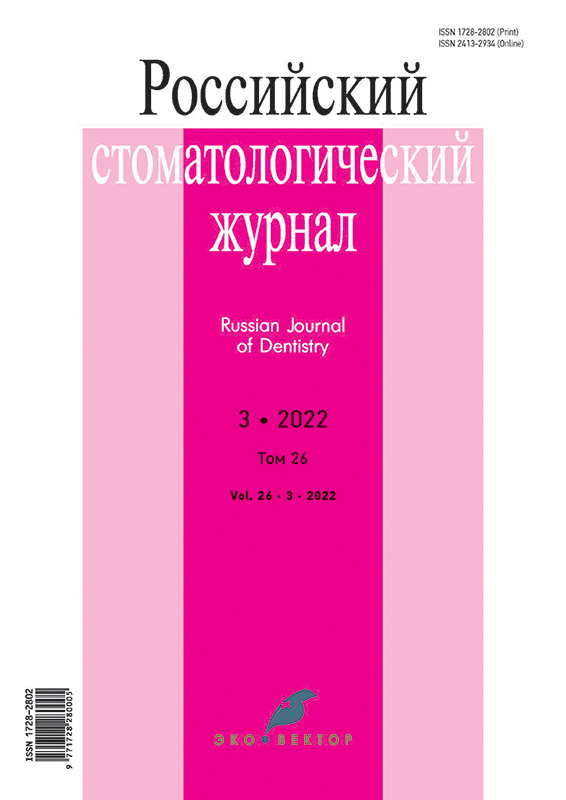Frenula of tongue and lips: are there or not?
- Authors: Aleksandrova O.V.1
-
Affiliations:
- Sechenov First Moscow State Medical University (Sechenov University)
- Issue: Vol 26, No 3 (2022)
- Pages: 191-197
- Section: Clinical Investigations
- Submitted: 01.11.2021
- Accepted: 12.05.2022
- Published: 28.09.2022
- URL: https://rjdentistry.com/1728-2802/article/view/84476
- DOI: https://doi.org/10.17816/1728-2802-2022-26-3-191-197
- ID: 84476
Cite item
Abstract
BACKGROUND: The absence, hypoplasia, or hyperplasia of the frenula of the lips and tongue is suggested as a sign of some diseases. This study assessed the presence of frenula among patients with orthodontic concerns.
AIM: This study aimed to analyze the prevalence of the absence of the frenulum of the tongue and lips to determine the possibility of using the absence of frenula as a diagnostic criterion for other pathologies.
MATERIALS AND METHODS: A retrospective analysis photographs of 391 patients was performed.
RESULTS: In total, 100% of the patients have a maxillary frenulum. The inferior labial frenulum was absent in 67.02% of the patients, and 252 patients (95% CI 62.27–71.77%) had multiple strands of the mucosal membrane. Hypoplastic mandibular frenulum was found in 109 (28.99%) patients (95% CI 24.4–33.58%). Absence of lingual frenulum was noted in 6 (1.68%) patients (95% CI 0.35–3.01%) and hypoplasia in 33 (9.24%) (95% CI 6.24–12.24%).
CONCLUSIONS: The absence of inferior labial and lingual frenulum cannot be a diagnostic criterion for other pathologies without specifying the method of displacement of the lower lip.
Full Text
About the authors
Olga V. Aleksandrova
Sechenov First Moscow State Medical University (Sechenov University)
Author for correspondence.
Email: aleksandrovastom@yandex.ru
ORCID iD: 0000-0002-0160-1698
Russian Federation, Moscow
References
- Petrovsky BV, editor. Encyclopedic dictionary of medical terms. Vol. 3. Moscow: Sovetskaya entsiklopediya; 1984. P:1241–1242. (In Russ).
- Devishree GSK, Shubhashini PV. Frenectomy: a review with the reports of surgical techniques. J Clin Diagn Res. 2012;6(9):1587–1592. doi: 10.7860/JCDR/2012/4089.2572
- Telebaeva GT, Sharipova SK. Abnormal lip and tongue frenulum: classification, terminology approach to diagnostic. Bulletin of the Kazakh National Medical University. 2014;(2):107–111 (In Russ).
- Odolskiy AV. Comparative analysis of excision techniques of labial and tongue frenulums, mucous membrane bands using a surgical scalpel and diode laser. Medical Bulletin of the Ministry of Internal Affairs. 2013;(3):78–79 (In Russ).
- Iwanaga J, Takeuchi N, Oskouian RJ, Tubbs RS. Clinical Anatomy of the Frenulum of the Oral Vestibule. Cureus. 2017;9(6):e1410. doi: 10.7759/cureus.1410
- Chu MW, Bloom DC. Posterior ankyloglossia: a case report. Int J Pediatr Otorhinolaryngol. 2009;73(6):881–883. doi: 10.1016/j.ijporl.2009.02.011
- Mills N, Pransky SM, Geddes DT, Mirjalili SA. What is a tongue tie? Defining the anatomy of the in-situ lingual frenulum. Clin Anat. 2019;32(6):749–761. doi: 10.1002/ca23343
- Mills N, Geddes DT, Amirapu S, Mirjalili SA. Understanding the lingual frenulum: histological structure, tissue composition, and implications for tongue tie surgery. Int J Otolaryngol. 2020:1820978. doi: 10.1155/2020/1820978
- Martin RA, Jones KL. Absence of the superior labial frenulum in holoprosencephaly: a new diagnostic sign. J Pediatr. 1998;133(1):151–153. doi: 10.1016/S0022-3476(98)70198-2
- Mintz SM, Siegel MA, Seider PJ. An overview of oral frena and their association with multiple syndromic and nonsyndromic conditions. Oral Surg Oral Med Oral Pathol Oral Radiol Endod. 2005;99(3):321–324. doi: 10.1016/j.tripleo.2004.08.008
- De Felice C, Toti P, Di Maggio G, et al. Absence of the inferior labial and lingual frenula in Ehlers-Danlos syndrome. Lancet. 2001;357(9267):1500–1502. doi: 10.1016/S0140-6736(00)04661-4
- Böhm S, Martinez-Schramm A, Gille J, Behrens P. Missing inferior labial and frenula in Ehlers-Danlos syndrome. Lancet. 2001;385(9293):1647–1648. doi: 10.1016/S0140-6736(01)06684-3
- Shankar S, Shirley E, Burrows NP. Absence of inferior labial or lingual frenula is not a useful clinical marker for Ehlers-Danlos syndrome in the UK. J Eur Acad Dermatol Venereol. 2006;20(10):1383–1384. doi: 10.1111/j.1468-3083.2006.01736.x
- De Felice C, Di Maggio G, Zagordo L, et al. Hypoplastic or absent mandibular frenulum: a new predictive sign of infantile hypertrophic pyloric stenosis. J Pediatr. 2000;136(3):408–410 doi: 10.1067/mpd.2000.103506
Supplementary files











